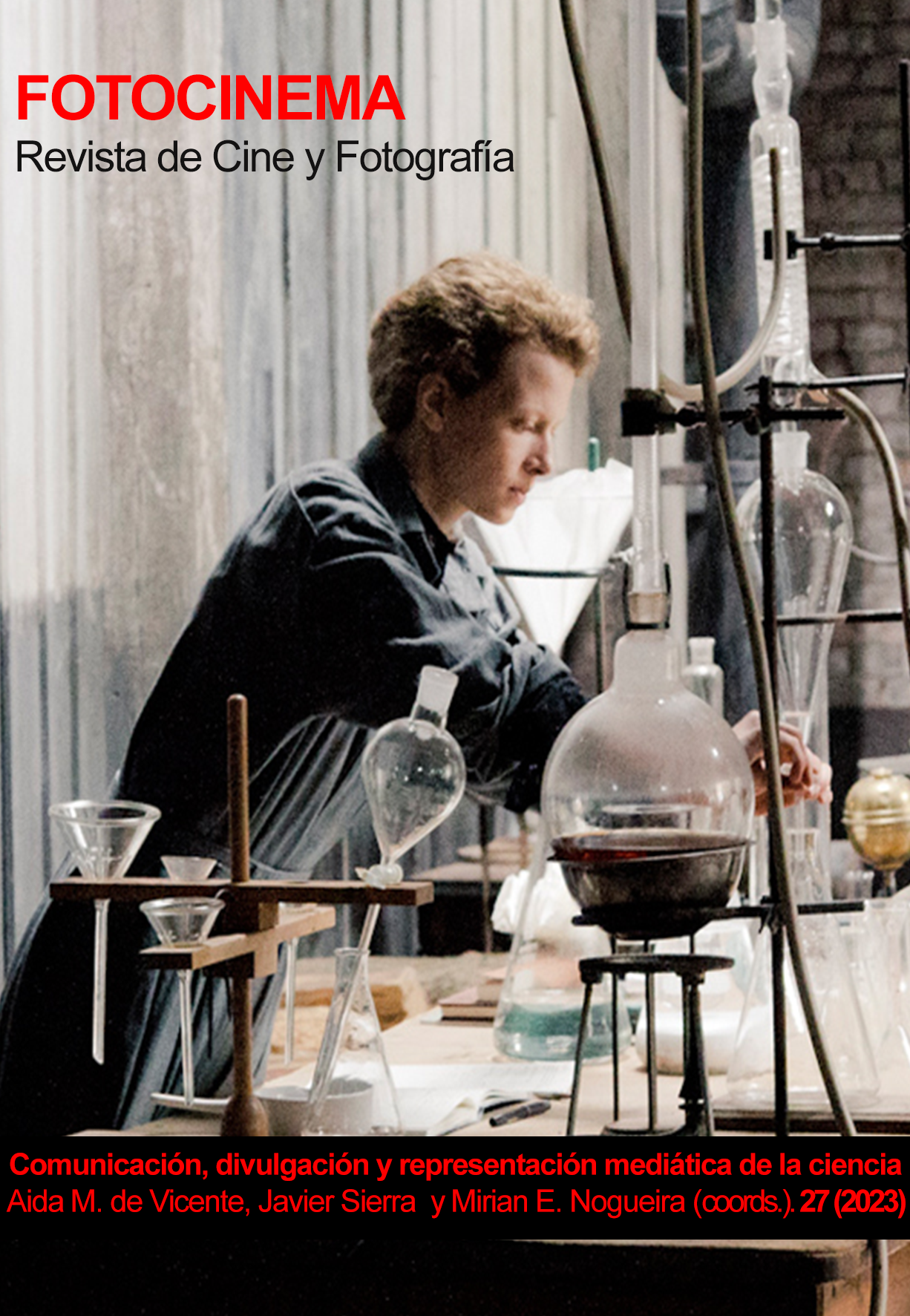Premios Goya entre milenios. Directoras de cine más valoradas por la Academia de 1990 a 2010 y aportaciones feministas de sus largometrajes
DOI:
https://doi.org/10.24310/Fotocinema.2023.vi27.16526Keywords:
Awards Spanish, Women Directors, Feminism, discriminationAbstract
The Goya Awards editions celebrated between the last decade of the XX centrury and the first of the XXI century, reveal the discrimination to women in Spain in the work, social and cultural environment, suffered from previous decades. Between 1990 and 2010 a new women directors generation emerge and gets to consolidate in the cinema industry because of the differentiating features of their films. However only a low rate of the movies directed by these women got the appretiation of the Spanish Academia de las Artes y las Ciencias Cinematográficas (Spanish Film Academy), such as Pilar Miró and Ángeles González-Sinde, in which case is noteworthy to comment their politic activity before and during their professional career. While taking into account how affected the emergence of private television channels to filming creativity during these two decades, this researchment analyses the gender discrimination in the cinema industry that influenced the Spanish Film Academy appretiation to these director´s movies, expressed by Goya Awards editions celebrated between the milennia. The methodology used has been the qualitative-quantitaive analyse completed by personal interviews to sector professionals and CIMA delegates (Women Directors and Professionals in Audioviusal Media Asociation).
Downloads
Metrics
References
Academia de Cine. Ediciones anteriores. 1990-2010. https://www.premiosgoya.com/los-goya/que-son/
Babbie, E. (2000). Fundamentos de la investigación social. Intemational Thomson Editores.
Bernárdez-Rodal, A., y Padilla-Castillo, G. (2018). Mujeres cineastas y mujeres representadas en el cine comercial español (2001-2016). Revista Latina de Comunicación Social, 73, 1247-1266. http://www.revistalatinacs.org/073paper/1305/64es.html
Castellani, J. P. (1996). Icíar Bollaín, la crisálida del cine español. Hispanica XXI, (14), 163-168. https://dialnet.unirioja.es/servlet/articulo?codigo=3609087
De Riquer, B. (2013). La dictadura de Franco, vol. I. Crítica-Marcial Pons.
El País. (2020). José María González-Sinde. https://elpais.com/noticias/jose-maria-gonzalez-sinde/
Fernández, C., y Checa, F. (2010). El cine de Pilar Miró. Homenaje y puente hacia la literatura. Arbor Ciencia, Pensamiento y Cultura, 186(741), 79-88. https://doi.org/10.3989/arbor.2010.741n1008
Guarinos Galán, V. (2018). Envejecimiento (de tópicos) activo(s) en el cine español de las décadas del “bienestar”. Área Abierta. Revista de comunicación audiovisual y publicitaria, 19(1), 59-73. http://dx.doi.org/10.5209/ARAB.61154
Jurado, J. (2018). Mujer, roles de género y política de premios en el cine español (1940-1959). Investigaciones feministas, 9(1), 119-135. https://revistas.ucm.es/index.php/INFE/article/view/56014
Louis, A. (2018). Private pain versus public shame: González Sinde’s female lawyer in la suerte dormida/sleeping luck (2003). Law and Humanities, 12(1), 17-41. https://doi.org/10.1080/17521483.2018.1447297
Loyo, H. (2017). The Holocaust trope: traumatic memory and melodrama in Isabel Coixet´s La vida secreta de las palabras (The Secret Life of Words, 2005). A Journal of Culture and History, 24(3), 354-376. https://doi.org/10.1080/17504902.2017.1411638
Mañas Martínez, M. del M. (2003). Reflexiones sobre El perro del hortelano de Pilar Miró. Dicenda. Estudios De Lengua Y Literatura españolas, 21, 139-156. https://revistas.ucm.es/index.php/DICE/article/view/DICE0303110139A
Martín Sanz, A. (2019). El cine de Mar Coll: herencias catalanas de Eric Rohmer. Fotocinema: revista científica de cine y fotografía, 19, 327-350. https://dialnet.unirioja.es/servlet/articulo?codigo=7167914
Martínez, M. (2008). Women on the other side of the camera. Where are the Women Cinema Directors? Espacio, Tiempo y Forma, Serie VII, Hª del Arte, 20-21, 315-340.
Mateos-Pérez, J., y Cabeza San Deogracias, J. (2015). El cine durante la primera competencia televisiva española (1990-1994). La piedra angular de la programación. Signo y Pensamiento, 34(67), 76-92. http://dx.doi.org/10.11144/Javeriana.syp34-67.cdf
Maurer, I. (2007). Isabel Coixet y su vida sin mí. En B. Pohl y J. Turschmann (Eds), Miradas glocales. Cine español en el cambio de milenio (pp. 249-269). Iberoamericana.
Ministerio de Cultura (2013). Mujeres y cultura. Políticas de igualdad.
Olivares, C. (29 de septiembre de 2010). España, se disparan las ventas de smartphones. Hipertextual. https://hipertextual.com/2010/09/espana-se-disparan-las-ventas-de-smartphones
Ors Marqués, M. (2016). Identidad/es. Una reflexión sobre las identidades de la mujer en el cine de Icíar Bollaín y Gracia Querejeta. Revista Internacional de Filosofía, (5), 307-331. http://dx.doi.org/10.6018/daimon/271321
Pérez Granado, V. (2006). 20 años de Goyas al cine español. Aguilar.
Tello Díaz, L. (2016). La 'mirada femenina': estereotipos y roles de género en el cine español (1918-2015). Ámbitos: Revista Internacional de Comunicación, 34, 1-16. https://institucionales.us.es/ambitos/la-mirada-femenina-estereotipos-y-roles-de-genero-en-el-cine-espanol-1918-2015/
Wimmer, R. D., y Dominick J. R. (1996). La investigación científica de los medios de comunicación. Una introducción a sus métodos. Bosch Casa Editorial.
Downloads
Published
How to Cite
Issue
Section
License
All contents published in Fotocinema Revista científica de cine y fotografía are protected under the Creative Commons Attribution-NonCommercial-ShareAlike 4.0 International (CC BY-NC-SA 4.0) license. All about this license is available in the following link: <http://creativecommons.org/licenses/by-nc-sa/4.0>
Users can copy, use, redistribute, share and exhibit publicly as long as:
- The original source and authorship of the material are cited (Journal, Publisher and URL of the work).
- It is not used for comercial purposes.
- The existence of the license and its especifications are mentioned.
There are two sets of authors’ rights: moral and property rights. Moral rights are perpetual prerogatives, unrenounceable, not-transferable, unalienable, imprescriptible and inembargable. According to authors’ rights legislation, Fotocinema. Revista científica de cine y fotografía recognizes and respects authors moral rights, as well as the ownership of property rights, which will be transferred to University of Malaga in open access. The property rights are referred to the benefits that are gained by the use or the dissemination of works. Fotocinema. Revista científica de cine y fotografía is published in an open access form and it is exclusively licenced by any means for doing or authorising distribution, dissemination, reproduction, , adaptation, translation or arrangement of works.
Authors are responsable for obtaining the necessary permission to use copyrighted images.













13.png)




